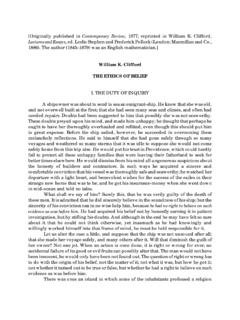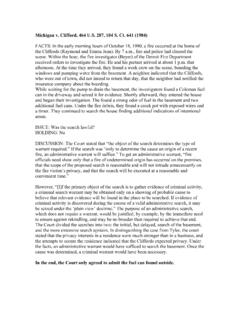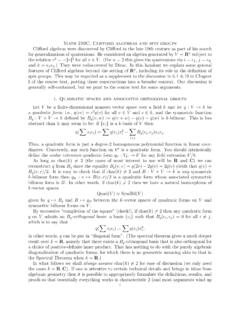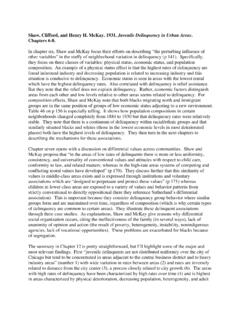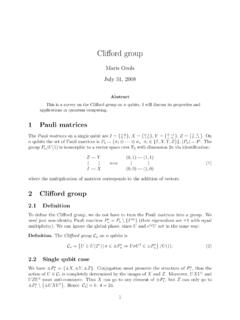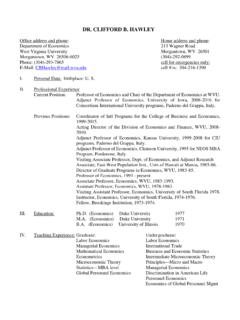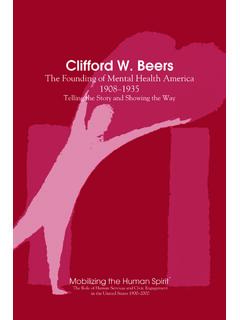Transcription of Author: Clifford D. Simak - users.tmok.com
1 Title: city Author: Clifford D. Simak Original copyright year: 1952 city Clifford D. Simak EDITOR'S PREFACE These are the stories that the Dogs tell when the fires burn high and the wind is from the north. Then each family circle gathers at the hearthstone and the pups sit silently and listen and when the story's done they ask many questions: "What is Man?" they'll ask. Or perhaps: "What is a city ?" Or: "What is a war?" There is no positive answer to any of these questions. There are suppositions and there are theories and there are many educated guesses, but there are no answers. In the family circle, many a storyteller has been forced to fall back on the ancient explanation that it is nothing but a story, there is no such thing as a Man or city , that one does not search for truth in a simple tale, but takes it for its pleasure and lets it go at that.
2 Explanations such as these, while they may do to answer pups, are no explanations. One does search for truth in such simple tales as these. The legend, consisting of eight tales, has been told for countless centuries. So far as can be determined, it has no historic starting point; the most minute study of it fails entirely to illustrate the stages of its development. There is no doubt that through many years of telling it has become stylized, but there is no way to trace the direction of its stylization. That it is ancient and, as some writers claim, that it may be of non-Doggish origin in part, is borne out by the abundance of jabberwocky which studs the tales-words and phrases, (and worst of all, ideas) which have no meaning now and may have never had a meaning.
3 Through telling and retelling, these words and phrases have become accepted, have been assigned, through context, a certain arbitrary value. But there is no way of knowing whether or not these arbitrary values even approximate the original meaning of the words. This edition of the tales will not attempt to enter into the many technical arguments concerning the existence or nonexistence of Man, of the puzzle of the city , of the several theories relating to war, or of the many other questions which arise to plague the student who would seek in the legend some evidence of its having roots in some basic or historic truth. The purpose of this edition is only to give the full, unexpurgated text of the tales as they finally stand.
4 Chapter notes are utilized to point out the major points of speculation, but with no attempt at all to achieve conclusions. For those who wish some further understanding of the tales or of the many points of consideration which have arisen over them there are ample texts, written by Dogs of far greater competence than the present editor. Recent discovery of fragments of what originally must have been an extensive body of literature has been advanced as the latest argument which would attribute at least part of the legend to mythological (and controversial) Man rather than to the Dogs. But until it can be proved that Man did, in fact, exist, argument that the discovered fragments originated with Man can have but little point.
5 Particularly significant or disturbing, depending upon the viewpoint that one takes, is the fact that the apparent title of the literary fragment is the same as the title of one of the tales in the legend here presented. The word itself, of course, is entirely meaningless. The first question, of course, is whether there ever was such a creature as Man. At the moment, in the absence of positive evidence, the sober consensus must be that there was not, that Man, as presented in the legend, is a figment of folklore invention. Man may have risen in the early days of Doggish culture as an imaginary being, a sort of racial god, on which the Dogs might call for help, to which they might retire for comfort.
6 Despite these sober conclusions, however, there are those who see in Man an actual elder god, a visitor from some mystic land or dimensions, who came and stayed awhile and helped and then passed on to the place from which he came. There still are others who believe that Man and Dog may have risen together as two co-operating animals, may have been complementary in the development of a culture, but that at some distant point in time they reached the parting of the ways. Of all the disturbing factors in the tales (and they are many) the most disturbing is the suggestion of reverence which is accorded Man. It is hard for the average reader to accept this reverence as mere story-telling.
7 It goes far beyond the perfunctory worship of a tribal god; one almost instinctively feels that it must be deep-rooted in some now forgotten belief or rite involving the pre-history of our race. There is little hope now, of course, that any of the many areas of controversy which revolve about the legend ever will be settled. Here, then, are the tales, to be read as you see fit-for pleasure only, for some sign of historical significance, for some hint of hidden meaning. Our best advice to the average reader: Don't take them too much to heart, for complete confusion, if not madness, lurks along the road. NOTES ON THE FIRST TALE There is no doubt that, of all the tales, the first is the most difficult for the casual reader.
8 Not only is its nomenclature trying, but its logic and its ideas seem, at first reading, to be entirely alien. This may be because in this story and the next a Dog plays no part, is not even mentioned. From the opening paragraph in this first tale the reader is pitchforked into an utterly strange situation, with equally strange characters to act out its solution. This much may be said for the tale, however-by the time one has laboured his way through it the rest of the tales, by comparison, seem almost homey. Overriding the entire tale is the concept of the city . While there is no complete understanding of what a city might be, or why it should be, it is generally agreed that it must have been a small area accommodating and supporting a large number of residents.
9 Some of the reasons for its existence are superficially explained in text, but Bounce, who has devoted a lifetime to the study of the tales, is convinced that the explanation is no more than the clever improvisations of an ancient storyteller to support an impossible concept. Most students of the tales agree with Bounce that the reasons as given in the tale do not square with logic and some, Rover among them, have suspected that here we may have an ancient satire, of which the significance has been lost. Most authorities in economics and sociology regard such an organization as a city an impossible structure, not only from the economic standpoint, but from the sociological and psychological as well.
10 No creature of the highly nervous structure necessary to develop a culture, they point out, would be able to survive within such restricted limits. The result, if it were tried, these authorities say, would lead to mass neuroticism which in a short period of time would destroy the very culture which had built the city . Rover believes that in the first tale we are dealing with almost pure myth and that as a result no situation or statement can be accepted at face value, that the entire tale must be filled with a symbolism to which the key has long been lost. Puzzling, however, is the fact that if it is a myth-concept, and nothing more, that the form by now should not have rounded itself into the symbolic concepts which are the hallmark of the myth.
